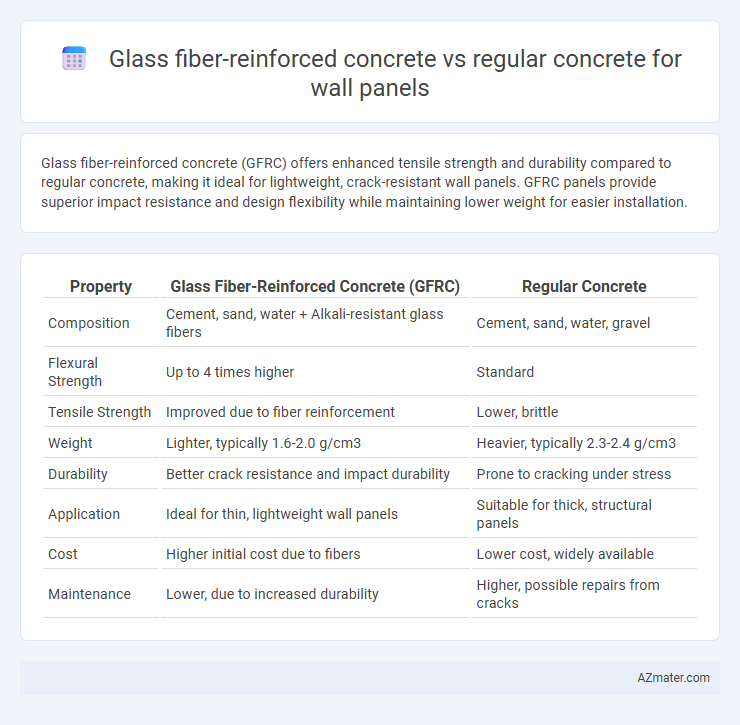Glass fiber-reinforced concrete (GFRC) offers enhanced tensile strength and durability compared to regular concrete, making it ideal for lightweight, crack-resistant wall panels. GFRC panels provide superior impact resistance and design flexibility while maintaining lower weight for easier installation.
Table of Comparison
| Property | Glass Fiber-Reinforced Concrete (GFRC) | Regular Concrete |
|---|---|---|
| Composition | Cement, sand, water + Alkali-resistant glass fibers | Cement, sand, water, gravel |
| Flexural Strength | Up to 4 times higher | Standard |
| Tensile Strength | Improved due to fiber reinforcement | Lower, brittle |
| Weight | Lighter, typically 1.6-2.0 g/cm3 | Heavier, typically 2.3-2.4 g/cm3 |
| Durability | Better crack resistance and impact durability | Prone to cracking under stress |
| Application | Ideal for thin, lightweight wall panels | Suitable for thick, structural panels |
| Cost | Higher initial cost due to fibers | Lower cost, widely available |
| Maintenance | Lower, due to increased durability | Higher, possible repairs from cracks |
Introduction to Wall Panel Materials
Glass fiber-reinforced concrete (GFRC) enhances traditional concrete by incorporating alkali-resistant glass fibers, improving tensile strength and durability in wall panel applications. Unlike regular concrete, GFRC offers superior resistance to cracking and impact, making it ideal for thinner, lightweight wall panels with intricate designs. The material's versatility and enhanced performance provide architects and builders with innovative solutions for modern facade and cladding systems.
Composition of Glass Fiber-Reinforced Concrete (GFRC)
Glass Fiber-Reinforced Concrete (GFRC) consists of a cementitious matrix combined with alkali-resistant glass fibers, sand, water, and additives that enhance durability and workability. The glass fibers, typically 12-18 mm in length, provide tensile strength and crack resistance, making GFRC ideal for wall panels requiring enhanced flexibility and impact resistance. Compared to regular concrete, GFRC's fiber reinforcement allows for thinner, lighter panels with superior structural performance and reduced potential for shrinkage cracking.
Composition of Regular Concrete
Regular concrete primarily consists of cement, water, fine aggregates like sand, and coarse aggregates such as gravel or crushed stone, forming a mixture known for its compressive strength and durability in wall panel construction. The hydration process between cement and water creates a hardened matrix, binding the aggregates into a solid mass that supports structural loads. This composition lacks the tensile reinforcement found in glass fiber-reinforced concrete, which can limit its crack resistance and impact strength in wall panel applications.
Mechanical Properties Comparison
Glass fiber-reinforced concrete (GFRC) exhibits superior tensile strength and flexural performance compared to regular concrete, enhancing durability and crack resistance in wall panels. The incorporation of glass fibers improves impact resistance and reduces brittleness, allowing for thinner, lighter panels without compromising structural integrity. GFRC's enhanced mechanical properties result in increased load-bearing capacity and extended service life, making it preferable for high-performance architectural applications.
Weight and Structural Efficiency
Glass fiber-reinforced concrete (GFRC) offers significantly reduced weight compared to regular concrete, often weighing 30-50% less, which enhances ease of handling and installation for wall panels. The incorporation of glass fibers increases tensile strength and improves crack resistance, leading to higher structural efficiency and durability in thinner sections. This weight and strength advantage allows for slender, lightweight panels that reduce overall structural load without compromising performance.
Durability and Longevity
Glass fiber-reinforced concrete (GFRC) exhibits superior durability and longevity compared to regular concrete due to its enhanced tensile strength and resistance to cracking. The incorporation of glass fibers improves impact resistance and reduces shrinkage, resulting in wall panels that withstand environmental stressors such as freeze-thaw cycles and corrosion more effectively. GFRC wall panels typically have an extended service life, making them ideal for applications requiring long-term structural integrity and low maintenance.
Design Flexibility and Aesthetics
Glass fiber-reinforced concrete (GFRC) offers superior design flexibility for wall panels compared to regular concrete, allowing for intricate shapes, thin sections, and detailed textures without compromising strength. GFRC's lightweight composition minimizes structural load, enabling larger spans and more complex architectural forms that enhance aesthetic appeal. The material's ability to incorporate various pigments and finishes provides a wide range of color and surface customization options, making it ideal for visually striking, durable wall panels.
Installation and Handling Differences
Glass fiber-reinforced concrete (GFRC) wall panels offer enhanced flexibility and lighter weight compared to regular concrete panels, simplifying transportation and reducing the risk of damage during handling. GFRC panels can be installed using thinner sections and less structural support, accelerating installation times and minimizing labor costs. In contrast, regular concrete panels are heavier and more brittle, requiring specialized equipment and increased caution to avoid cracking and ensure safe installation.
Cost Analysis: GFRC vs Regular Concrete
Glass fiber-reinforced concrete (GFRC) wall panels typically incur higher initial material costs compared to regular concrete due to the inclusion of glass fibers and specialized manufacturing processes. However, GFRC offers cost savings over time through reduced weight, which lowers transportation and installation expenses, and improved durability that minimizes maintenance and repair costs. In large-scale projects, the lifecycle cost efficiency of GFRC can outweigh the upfront price difference when compared to regular concrete wall panels.
Sustainability and Environmental Impact
Glass fiber-reinforced concrete (GFRC) offers enhanced sustainability benefits over regular concrete by requiring less cement content, thereby reducing CO2 emissions associated with cement production. GFRC's durability and lightweight properties extend the lifespan of wall panels and lower transportation energy, minimizing the overall environmental footprint. Regular concrete panels have higher embodied energy and often require thicker sections, resulting in increased resource consumption and waste generation during construction and demolition phases.

Infographic: Glass fiber-reinforced concrete vs Regular concrete for Wall panel
 azmater.com
azmater.com